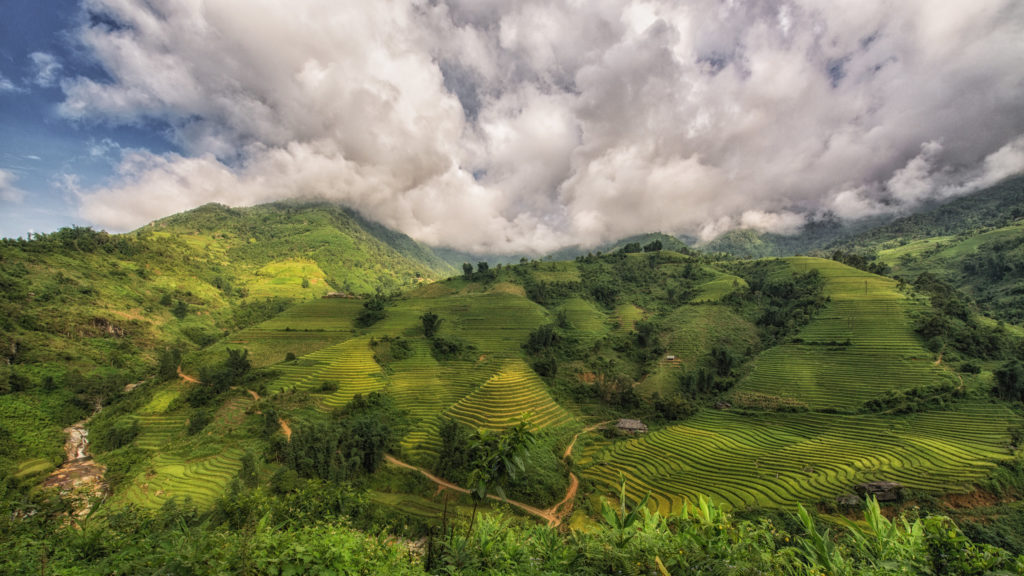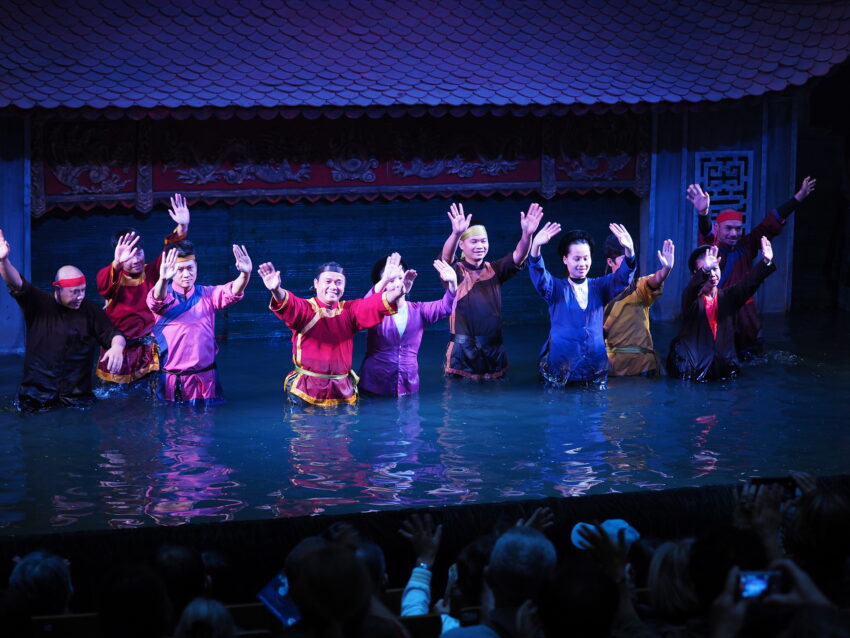
4 days in Vietnam are more than enough to fall in love with this beautiful country. There is a long list of things to do and places to see in this Asian country. Outstanding landscapes and natural scenery stand next to historic architecture and man-made tourist attractions. Vietnam is widely known as an extremely poor country, however, this fact does not take the wonder and intrinsic beauty away from it. And with how lovely people are everywhere, you will come back to Vietnam sooner than later.
People often underestimate the real size of Vietnam, thinking at first that it’s small and easy to explore. But there’s a catch. Vietnam is rather spread out, and a train ride from the northern capital of Hanoi to the southern Ho Chi Minh City takes around 35 hours. So you have to be aware that with only 4 days in Vietnam you can’t explore the country from North to South. However, even by visiting only one region of Vietnam, you will surely live one of the most satisfying experiences of your life.

Day 1
Explore the Capital
The city of Hanoi is the heart of Vietnam. Even though it has its share of busy streets filled with motorbikes, cars, bicycles and crowded markets, the traditional and artistic side of Vietnam remains untouched in the capital. Hanoi will surely delight you, as well as confuse you, because of the somewhat village vibe it still holds. Besides, the city keeps traditions that go back centuries in history, atypical for a capital city.

The Old Quarter
Hanoi’s Old Quarter is a place you certainly cannot miss. Its fascinating maze of busy streets takes you back in time to an era where every street was specifically made for one type of item. This Old Quarter is considered an open-air museum: Asian and French-colonial architecture undamaged even after the Vietnam War. For history lovers, Hanoi holds various outstanding museums, like the Vietnam Museum of Ethnology and Vietnam Fine Art Museum. Both are considered the foundation of the distinctive artistry in the country.

Vietnam’s street challenge
You can wander through the streets to get accustomed to the bustling, energetic life of Vietnam’s capital, as many foreigners feel overwhelmed by it. Crossroads and pedestrian lights are not that common, and crossing the street can feel somewhat like a challenge for you. But don’t panic! The best way to cross the street in Vietnam is to always walk as slowly as you can. This way, drivers can expect your next move and go around you. It takes a while to get used to this, but you will be safe.

Spend some money on these famous busy markets, try delicious coffee on eccentric cafes and then grab some food from one of the many, many street vendors. By the time the sun sets, you already got a glimpse of what everyday life is like for locals. Now, you can finish up your day in Hanoi watching the worldwide known Water Puppet Theatre.
The Water Puppet Theatre
Thang Long Water Puppet Theatre is one of the most popular attractions in Hanoi. This art form goes back to the 11th century when Vietnam’s famous rice paddy fields flooded. To shine some light on the dark times, villagers performed with their puppets, standing waist-deep into the water, bringing some entertainment and laughter to locals.

The Puppets go along to traditional Vietnamese music, played by an orchestra of drums, cymbals, horns, wooden bells, and bamboo flutes. This show is full of legends and tales with a hint of comedy that catches all your attention. The occasional singer shouting reassuring words at the puppets makes you feel like an innocent child all over again.

Day 2
Your second day is all about peace and tranquility. You will be heading out of the vibrating capital and into widespread paddy-fields, serpentine rivers, and mountains blanketed in the brightest green.
Ninh Binh: Vietnam’s Hidden Gem
Standing 100 km south of the capital of Hanoi, the town of Ninh Binh is considered the Hidden Gem of Northern Vietnam. The almost untouched natural scenery, combined with Vietnam’s ever-present historical and religious sites, is enough to place this town at the top of every traveler’s list.

Tam Coc
To get the best side of Ninh Binh you will have to divert a bit from the tourist trail. Then, you can reach one of the greatest nature sites of Vietnam: Tam Coc. In fact, this sea of green is known as “Halong Bay on land”. But unlike the crowded Halong Bay, Tam Coc gives you a quiet, relaxing environment. You can separate yourself from the city life and get in touch with nature while sailing on a boat trip down Tam Coc River. While sailing these waters, you get the feeling of being right in the middle of a movie scene. Pay attention, since there are religious sites hidden from plain sight.

The Mua Cave
If you wish to have an unforgettable view of Ninh Binh, climbing the 500 steps to the top of the Mua Cave is a must. The stone staircase takes around 15 minutes to climb, passing by karstic formations covered in verdant vegetation and colorful flowers. Once you reach the altar of Quan Am, Goddess of Mercy, the panoramic view is breathtaking. Look over rice paddies that seem to stretch beyond the horizon, an image that will forever stay with you.

Day 3
Halong Bay
Quiet turquoise waters dotted everywhere by karstic islands covered in lush jungles. Halong Bay is not only one of Vietnam’s most famous tourist sites, but also one of the world’s most astonishing views. Cruise along this UNESCO World Heritage Site, amid the thousands of islands eroded by the force of wind and water over millennia.

Halong’s Caves
Explore the Thien Cung Cave (“Heaven Cave”) and Hang Dao Go Cave, with their magnificent stalactites and stalagmites of different colors and sizes. Also, the largest cave on the bay, the Sung Sot Cave, known as the “Cave of Surprises” is waiting for you. You can go kayaking, and if the weather is on your side, swim from your boat around the bay.

While sailing the waters, some ships offer an onboard cooking class. Take the chance to learn more about Vietnam’s traditional dishes and try the fine cuisine, as you also learning how to prepare them. At the end of every class, your Cruise Chef will pick some of the passengers for a fun competition to find who can make the dish in the shortest time. So keep your eyes opened and pay attention to every detail!
But Halong Bay does not end here!
There are so many things to do in Halong Bay, that only one day is not enough. In fact, many people prefer to take an overnight cruise, a highly recommended option to get the best experience possible.
Day 4
Tai Chi classes
Start your second day on Halong Bay and last day on Vietnam with a Tai Chi class with a guru, while the sun slowly rises from the horizon. This Chinese martial art helps relieve stress and works as a meditation method. And with the sky turning into a mix of pink and orange colors with the sunrise, the feeling of peace and tranquility you get is one you won’t get to experience anywhere else.

And on this last day is when you get to explore the not-so-popular sides of Halong Bay. Meet the Trinh Nu Cave, artificially illuminated in a rainbow of colors. Or see some cute, playful monkeys while kayaking across Loun Cave. A relaxing, but still an excellent way to end your 4-day trip in Vietnam.

How to get there
Many flights arrive at Noi Bai international airport in Hanoi from all over the world. There is also very good accommodation, from hotels in Hanoi’s Old Quarter to bungalows in Ninh Binh.
When to go
If you’re wondering about the weather, it varies in all three regions. Vietnam is usually hot and humid, but Northern Vietnam can get pretty cold from November to April. On the other hand, it gets humid and hot from May to October.
Inside Information
Prices are usually cheap in Vietnam, but nothing is fixed. Get ready to bargain the best price once someone tries to inflate prices. People are lovely, but this is how they do business here.
For safety purposes, avoid tap water, and therefore salads and ice, since you never know how they have been washed or made. This is a well-known rule even locals stick to. And last but not least, be careful of your belongings. Vietnam is a safe country, but around busy streets, it’s recommended to hide all expensive objects and keep your phone safely in your pocket.

If you loved this article or found it useful, don’t forget to share it with your adventurous and travel-hacking friends! If you want more posts like this, follow us on Youtube, Instagram, Pinterest, Twitter or Facebook and subscribe to our newsletter!

